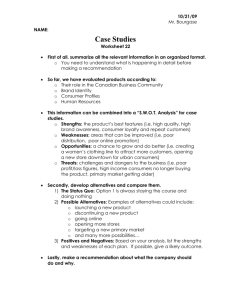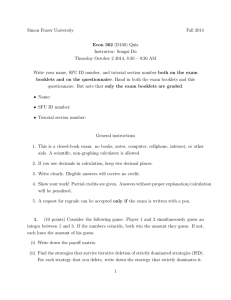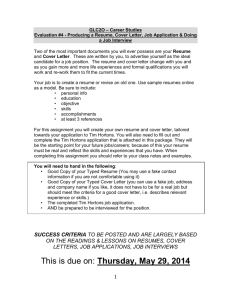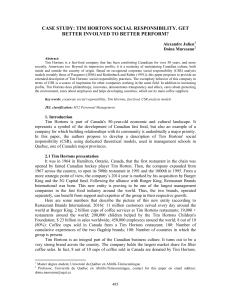Simon Fraser University Spring 2013 Econ 302 Midterm Exam Instructor: Songzi Du
advertisement
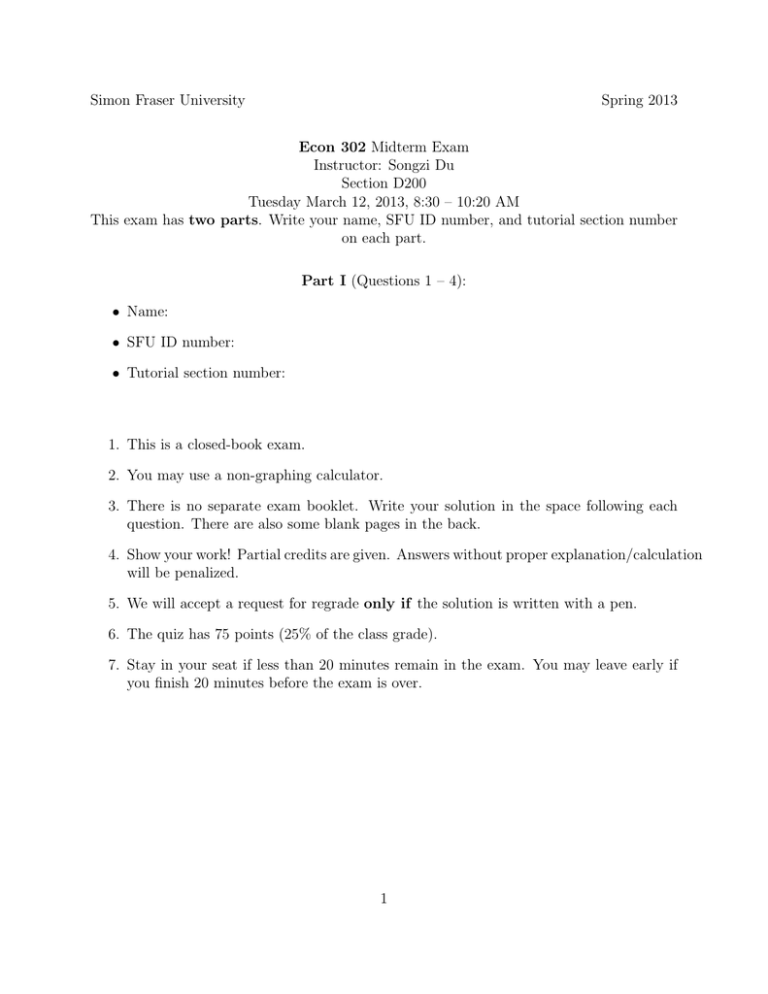
Simon Fraser University Spring 2013 Econ 302 Midterm Exam Instructor: Songzi Du Section D200 Tuesday March 12, 2013, 8:30 – 10:20 AM This exam has two parts. Write your name, SFU ID number, and tutorial section number on each part. Part I (Questions 1 – 4): • Name: • SFU ID number: • Tutorial section number: 1. This is a closed-book exam. 2. You may use a non-graphing calculator. 3. There is no separate exam booklet. Write your solution in the space following each question. There are also some blank pages in the back. 4. Show your work! Partial credits are given. Answers without proper explanation/calculation will be penalized. 5. We will accept a request for regrade only if the solution is written with a pen. 6. The quiz has 75 points (25% of the class grade). 7. Stay in your seat if less than 20 minutes remain in the exam. You may leave early if you finish 20 minutes before the exam is over. 1 1. Part i (7 points): Find the strategies that survive iterative deletion of strictly dominated strategies (ISD). For each strategy that you delete, write down the strategy that strictly dominates it. Part ii (8 points): Find all Nash equilibria (pure and mixed) in this game; and for each Nash equilibrium that you find, find the two players’ expected payoffs in the equilibrium. W X Y Z A 5, 0 0, 1 2, 1 3, 4 B 1, 3 3, 4 1, 7 10, 5 C 2, 3 1, 5 3, 1 4, 2 D 1, 10 1, 0 1, 5 4, 5 2 3 2. (10 points) The market (inverse) demand function for a homogeneous good is P (Q) = 30 − 2Q. There are 2 firms, each with a constant marginal cost of 3 for producing one unit of the good. The two firms compete by setting their quantities of production, and the price paid by the consumer is determined by the market demand function given the total quantity. Assume that the government imposes a sales (percentage) tax of 10% for firm 1 and a sales tax of 20% for firm 2; the taxes do not impact the firms’ costs. (Firm 1 is a domestic company and therefore receives special favors.) Calculate the Nash equilibrium in this game, and calculate the prices received by the two firms as well as the consumer price in this equilibrium. (Hint: there is only one consumer price.) 4 5 3. (10 points) Find all pure-strategy subgame perfect equilibria of the following game. 1 a 2 c 2 1 e b 2 d −1 0 2 c 0 0 0 1 6 g f d 1 1 h i j k 1 4 0 3 2 3 0 4 7 4. (10 points) Tim Hortons is the only coffee place in WMC and makes a yearly profit of $100,000. Random-Coffeehouse contemplates entering the coffee market in WMC, incurring setup-costs of $25,000, which will force Tim Hortons to share its profits 50-50 with them. Tim Hortons vows to sell coffee at cost, if necessary, to preserve its monopoly position. The sequence of moves is that Random-Coffeehouse first decides to enter or not enter the market; if not entering, the payoffs of Random-Coffeehouse (Player 1) and Tim Hortons (Player 2) are (0, 100000). If Random-Coffeehouse enters, Tim Hortons then decides to fight (leading to payoffs of (−25000, 10000)) or accommodate (leading to payoffs of (25000, 50000)) Random-Coffeehouse. Draw the game tree, and find the subgame perfect equilibrium. Is Tim Hortons’s threat to fight Random-Coffeehouse credible? 8 9 10 11 12 13 14
